Sitting all day is detrimental to your health. If you’ve seen friends or co-workers getting “standing desks,” then they’ve probably been told that sitting all day can slowly kill them. But it’s true, there are some truly adverse effects that happen from sitting down all day. It might seem like an exaggeration, but you can risk high blood pressure, abnormal cholesterol levels, premature death, and certain types of cancer. One of the reasons is because you burn fewer calories sitting down. Experts recommend moving every 20 to 30 minutes, but what if you’re too busy at the office for a quick stretch break? And no, trips to the bathroom and kitchen don’t count.
You don’t need to do laps around the office or run up and down the building stairwell. To combat the health risks of sitting down all day, it’s a matter of staying physically active. Fortunately, there are a number of discreet but effective exercises you can perform right from the convenience of your desk. The only equipment you’ll need is your office chair and dumbbells or a full water bottle.
Wrist Stretches
If you’re clicking and typing away all day, make sure your fingers and hands don’t end up stiff. Extend one arm in front, palm up and take the fingers with your other hand. Gently pull back your fingers towards you, stretching your forearm. Hold this for 20 to 30 seconds. Repeat with your other wrist. You can also press your hands together in front of your chest with your arms and elbows parallel to the floor. Bend your wrists to the right and to the left 10 times.
Lower Back Stretch
Prone to slouching? Take the strain off your spine. Sit tall and place your left arm behind your left hip. Gently twist to the left. Use your right hand to deepen the stretch and hold for 20 to 30 seconds. Repeat on the other side.
Leg Exercises
If you’re feeling a little wobbly when you get up after hours and hours of sitting, take a moment to get the blood flowing in your legs. Sit tall and engage your core. Extend your left leg until it’s level with your hip and squeeze your quadriceps. Hold this for two seconds, then lower. Repeat 16 times and then take it to the other side. You can also even throw in an inner thigh workout. Place a firm water bottle in between your knees and squeeze the bottle. Release your hold halfway and squeeze again. Complete 16 reps of slow pulses.
Squats and Dips

You might look a little funny doing these exercises, but you won’t be the one complaining about a sore butt later! Just be sure you keep your chair stable. To do a chair squat, lift up your hips just hovering over the chair with your arms out for balance. Hold this for 2 to 3 seconds. Stand all the way up. Repeat this for 15 reps. To do a dip, place your hands next your hips. Move your hips in front of the char and bend back the elbows while holding onto the chair. Lower your body until your elbows are out at 90 degrees. Push back and return to starting position. Do 15 reps.
Weights
You can stash a dumbbell or two in your drawer or underneath your desk, but if that’s not possible, a full water bottle will do in a pinch. You can first try a bit of weight training with your arms. To do a bicep curl, hold your dumbbell in your right hand, making sure your core is engaged and your spine is straight. Curl the dumbbell towards your shoulder. Repeat 15 times and do the same with your left side. Ab exercises are also totally possible behind your desk. Hold your dumbbell at chest level. Keep your knees and hips forward. Gently twist as far as you can (whilst sitting ‘tall’) and feel your abs stretch. Twist back to the centre and move to the left. Repeat 10 times.







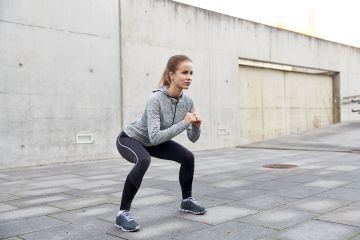

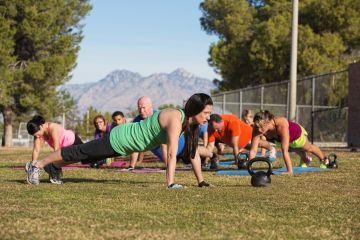 What’s more, scientific studies have backed up the power of high-intensity interval training (HIIT) when it comes to benefiting our bodies on a cellular level. One study observed that a group who did HIIT exercises for 12 weeks gained lean muscle, improved aerobic capacity, and a 49 per cent increase in the cells ability to take in more oxygen and produce more energy (mitochondrial capacity). Elderly people in this group actually experienced a 64 per cent boost.
What’s more, scientific studies have backed up the power of high-intensity interval training (HIIT) when it comes to benefiting our bodies on a cellular level. One study observed that a group who did HIIT exercises for 12 weeks gained lean muscle, improved aerobic capacity, and a 49 per cent increase in the cells ability to take in more oxygen and produce more energy (mitochondrial capacity). Elderly people in this group actually experienced a 64 per cent boost.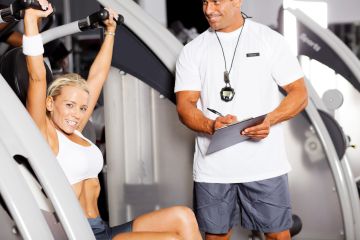

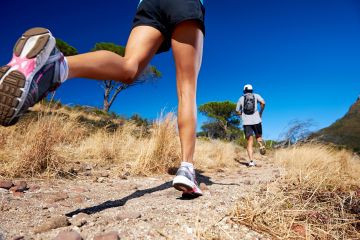

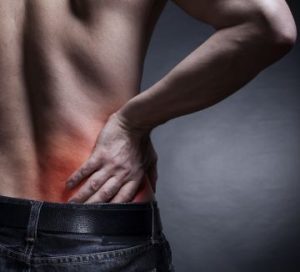 Deadlifts, cycling, and bent over rows can lead to pain in your spine and back muscles. When performing these exercises, it’s important to maintain the natural arch in the small of your back. To alleviate and prevent pain, you can try this before and after exercises: Create a hollow as large as you can in the small of your back and then round your lower back as much as you can, creating as much movement in the spine as you can. Repeat this for 15 to 20 times.
Deadlifts, cycling, and bent over rows can lead to pain in your spine and back muscles. When performing these exercises, it’s important to maintain the natural arch in the small of your back. To alleviate and prevent pain, you can try this before and after exercises: Create a hollow as large as you can in the small of your back and then round your lower back as much as you can, creating as much movement in the spine as you can. Repeat this for 15 to 20 times.